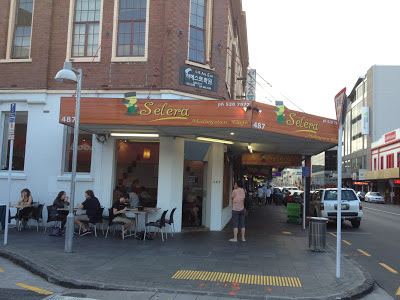[Added 16 October 2014: This blog post was about the Auckland Art Gallery Cafe run by
Dawsons. The current cafe in the Art Gallery is now operated by
Mojo.]
I love Auckland more each day. The city is alive now in a way it has never been before, even as little as five or even two years ago. I guess the Rugby World Cup brought about the biggest changes. Even though I mocked the tram on its tiny loop in Wynyard Quarter, I have total respect for the work that has been done on North Wharf. Go on a Friday night, when the
Silo Market is on, along with a
free open-air cinema session, and you will know what I mean.
 |
| Friday night Silo Park Market. |
Then there are the changes in Federal Street, including the ever-popular
Depot eatery, and the exciting little shops in
Ponsonby Central. The
Auckland Night Market is expanding beyond the
Pakuranga Saturday market and Glenfield Sunday market to include Friday nights at Hunter's Plaza in Papatoetoe and Thursday nights in Onehunga now too! The
Britomart area, which had once been "those dilapidated buildings opposite Showgirls with graffiti and broken windows", is now a pleasant place to be, both for the ambiance and the food options available. Even the cheap Chinese eateries on Dominion Road have stepped up, with
brand new signage highlighting their names in illuminated, colour-changing glory.
And there are promises of even more good things to come. The
City Works Depot has been revamped, and by the end of the year we will see a
new Al Brown restaurant there, as well as Michael van de Elzen's Foodtruck Garage (I saw his Food Truck parked there already). There is a
beautiful complex being built in Osborne Lane, Newmarket, with brickwork buildings and paved walkways, where I hope to see more great eateries.
One of the brightest jewels in our city's crown, of which all Aucklanders should be proud, is the new(-ish) Auckland Art Gallery on Lorne Street. And in this magnificent building, I will have you know, is one of the best cafes in Auckland, which, for some unknown reason, seems to have garnered some poor reviews, including in the
Herald (never mind that the writers complain about the temperature of the coffee or the length of the queue rather than having anything concrete to say about the quality of the dishes offered).
 |
| The cafe is on the next floor up, behind the floating flowers. |
The cafe is officially on the first floor of the art gallery, but you actually have to walk up two flights of steps from the main entrance, because there is an intervening floor called the Mezzanine. That's the one where you have a superb view of the floating flowers that open and close, which you can even see from outside the museum.
Run by
Dawsons Catering, the cafe changes its menu regularly, and also offers a special menu which is themed along the lines of the special exhibit which is running at the gallery. For instance, for the
Home AKL exhibit on Polynesian art last year, the special menu included a Samoan banquet fold over, ota ika raw fish salad, Fijian chicken curry, coconut rice pudding, and an "island passion" dessert with pineapple mousse, passionfruit gel, coconut dacquoise, and mango salsa.
The main menu gets updated too. We were impressed to find the old-fashioned dish of lamb's fry (liver) on the menu last year, served with a potato rosti that looked like a glorious, deep-fried slice of cake. That is no longer available, but other tempting menu items have taken its place.
 |
| Lambs fry, bacon, shallots, jus, potato rosti & watercress pesto. |
A highlight of the current menu is the soufflé, which had a strong smokey note, and went well with the bitterness of the radicchio and the sweetness of the roast pear pieces. The toasted hazelnuts boosted the flavour of the dish too, and it was more filling than it looked.
 |
| Soufflé twice baked, Mt Kyeburn smoked cheddar with radicchio, roast pear & hazelnut salad (partially eaten). |
Although we have an aversion to sweet breakfasts, the banana walnut eggy bread (which we would have called "French toast") was also enjoyable, if somewhat less exciting.
 |
| Banana walnut eggy bread with maple syrup, strawberry compote, cinnamon mascarpone and free range bacon. |
We have not yet tried the other items on the menu, but we liked the mix of traditional cafe breakfast dishes and a range of other choices. There are also counter options available, with the usual sandwiches, muffins and sweet treats, as well as salads.
 |
| Counter food. |
With their great selection of delicious and beautifully presented dishes, and a modern airy environment, including seating on the deck overlooking the front entrance, what's not to like about the Auckland Art Gallery Cafe? Oh, and did I mention that they only use free range eggs and bacon?
 |
| Seating on the balcony. |
Notes
The cafe does not take reservations.
Panda Recommends
We prefer the more lunchy items to the more breakfasty items here.
Mains: Soufflé Twice Baked with Mt Kyeburn Smoked Cheddar ($16.50), Linguine Pasta with peppered pancetta, leeks, summer greens, parmesan shavings and pistachio pesto ($18.50), Banana Walnut Eggy Bread ($14.50)
Vegie Pandas
You can have the soufflé too, though no doubt the other dishes are also tasty. The Green Vegetable Soup ($13.50) was under-seasoned though, when I tried it. Vegetarian, gluten free and dairy free items are clearly marked on the menu.
 |
| Menu - Feb 2013 |
Restaurant Details
Auckland Art Gallery Café
Corner of Kitchener and Wellesley Streets, Auckland Central
(09) 379 1349
Opening hours:
Mondays to Fridays 7:30am - 4:30pm (espresso bar 10am - 3:30pm)
Saturdays to Sundays 10am - 4:30pm (espresso bar 10am - 3:30pm)
 |
| Auckland Art Gallery from the outside. |













































